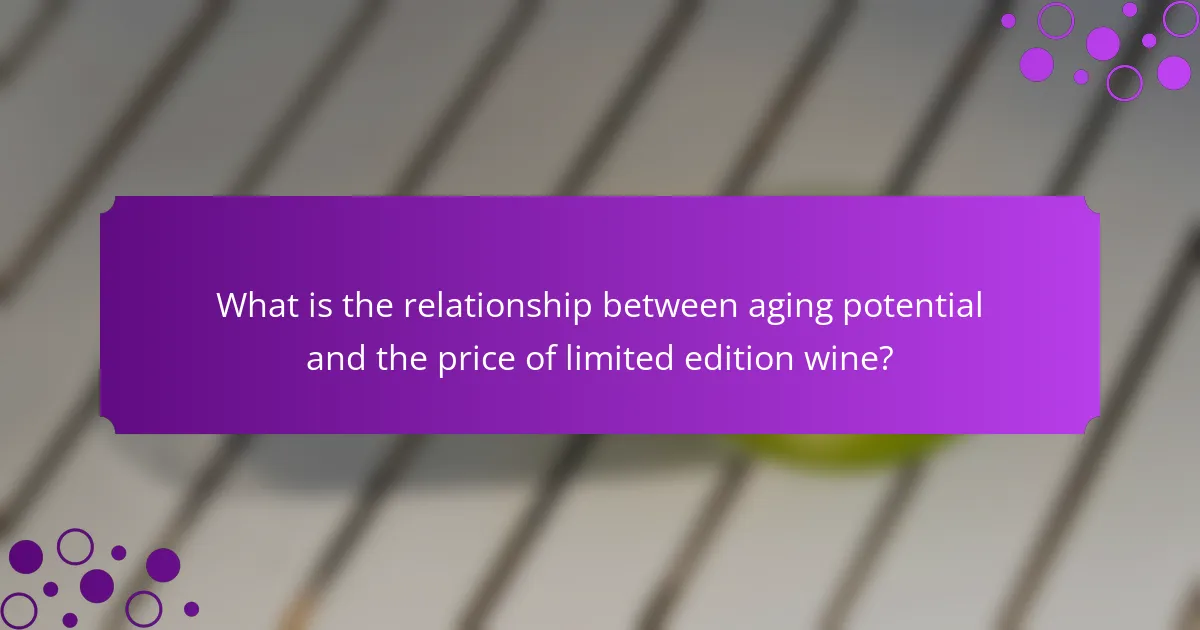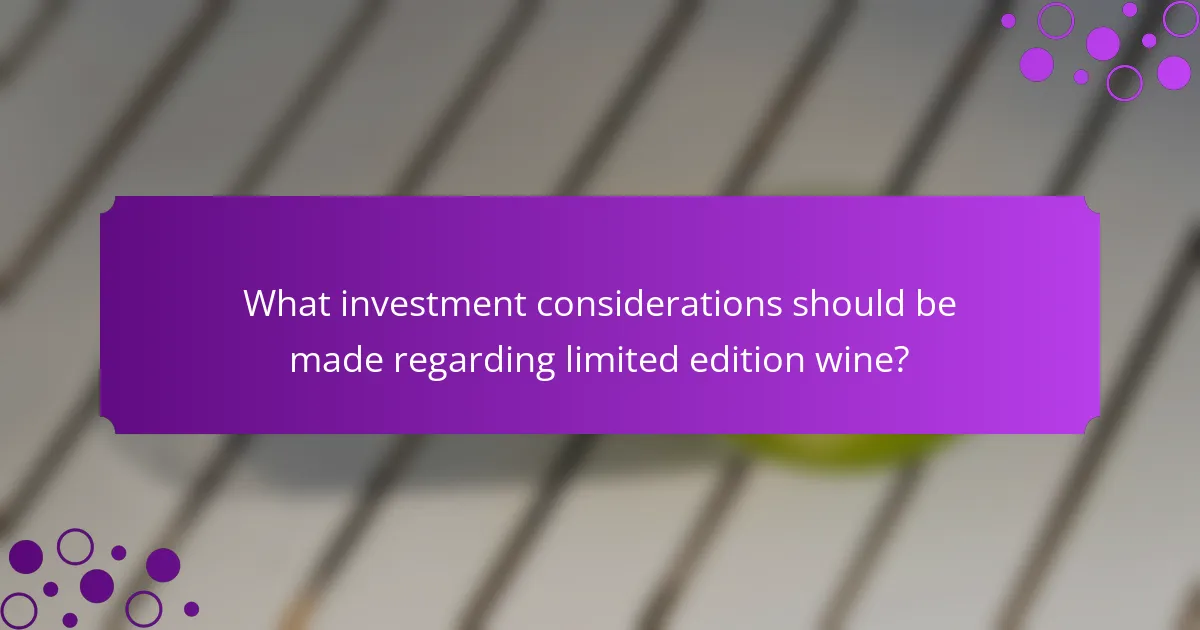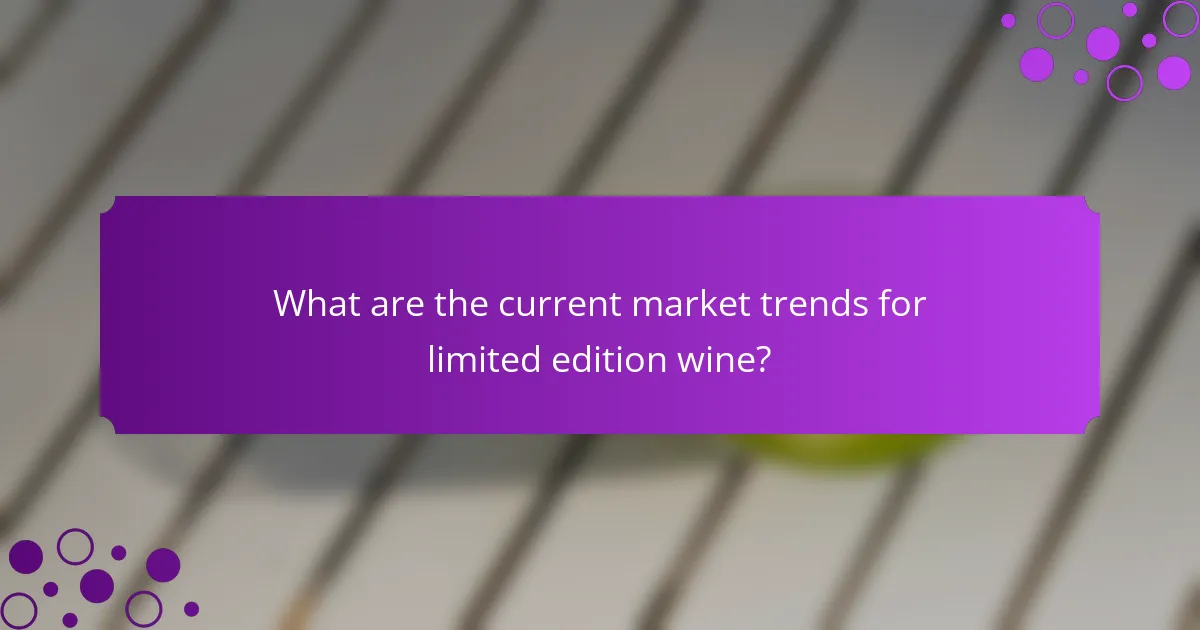
What is the relationship between aging potential and the price of limited edition wine?
Aging potential significantly influences the price of limited edition wine. Wines with higher aging potential often command higher prices. This is because they are perceived as having greater quality and complexity over time. Limited edition wines are typically crafted with superior grapes and meticulous techniques. These factors contribute to their ability to age well. Market demand for aged wines also drives up prices. Collectors and investors seek wines that will appreciate in value over time. Research by the Wine Market Council shows that age-worthy wines can appreciate by 10-15% annually. Thus, the relationship between aging potential and price is strong, with quality and demand as key drivers.
How is aging potential defined in the context of limited edition wine?
Aging potential in limited edition wine refers to the ability of the wine to improve in flavor, complexity, and overall quality over time. This potential is influenced by factors such as grape variety, acidity, tannin structure, and alcohol content. Wines with high aging potential often possess a balance of these elements, allowing them to evolve and mature gracefully. Limited edition wines are typically crafted with superior quality and care, enhancing their aging characteristics. Historical examples show that prestigious wines, like Bordeaux and Barolo, can appreciate in value as they age. Research indicates that wines aged for a decade or more often develop deeper flavors and aromas, making them more desirable to collectors.
What factors influence the aging potential of wine?
The aging potential of wine is influenced by several key factors. These factors include grape variety, acidity, tannin levels, alcohol content, and storage conditions. Grape variety plays a significant role, as some varieties naturally age better than others. For example, Cabernet Sauvignon tends to have a higher aging potential due to its robust structure. Acidity is crucial for preservation; higher acidity helps maintain freshness over time. Tannin levels also contribute; wines with higher tannins often age longer, as tannins soften and integrate with other flavors. Alcohol content impacts aging as well; wines with moderate alcohol levels generally age better. Finally, storage conditions, including temperature, humidity, and light exposure, can significantly affect a wine’s aging process. Proper storage ensures that wines develop their flavors and aromas optimally over time.
How does aging potential affect the wine’s flavor profile?
Aging potential significantly affects a wine’s flavor profile. Wines with high aging potential develop more complex flavors over time. This complexity arises from chemical reactions that occur during aging. Tannins and acidity soften, leading to a smoother mouthfeel. Additionally, fruity notes may evolve into more nuanced flavors like dried fruit or spice. The development of secondary and tertiary aromas occurs as well. For example, a young Cabernet Sauvignon may present bold fruit flavors. After aging, it can exhibit earthy or herbal notes. Research indicates that wines aged for a decade or more often show enhanced flavor depth and integration.
Why does price vary among limited edition wines with different aging potentials?
Price varies among limited edition wines with different aging potentials due to factors like rarity, production methods, and market demand. Wines with higher aging potential often come from select vineyards and are produced with meticulous techniques. These factors contribute to their perceived quality and desirability. Additionally, wines that can age longer typically develop complex flavors, which enhances their value. Market trends also influence pricing, as consumers may be willing to pay more for wines expected to appreciate over time. Thus, the interplay of these elements leads to price variations in limited edition wines.
What role do rarity and exclusivity play in pricing?
Rarity and exclusivity significantly influence pricing. Limited availability creates higher demand among consumers. This demand drives up the perceived value of the product. For example, rare wines often fetch prices significantly above their production costs. According to a study by the University of California, Berkeley, scarcity can increase consumer willingness to pay by up to 300%. Exclusive products also foster a sense of status among buyers. The combination of rarity and exclusivity thus establishes a premium pricing strategy. This phenomenon is evident in the fine wine market, where limited editions command higher prices.
How do market demand and supply dynamics impact price?
Market demand and supply dynamics directly influence price levels. When demand for a product increases, prices tend to rise if supply remains constant. Conversely, if supply increases while demand remains steady, prices are likely to fall. For example, in the limited edition wine market, high demand can lead to increased prices, especially when the supply is limited. Historical data shows that collectible wines often see price surges during auctions when demand outstrips available bottles. This relationship is a fundamental principle of economics, observable in various markets.
How can one assess the value of limited edition wine based on aging potential?
To assess the value of limited edition wine based on aging potential, one should evaluate several key factors. First, the grape variety significantly influences aging potential. For instance, Cabernet Sauvignon and Syrah are known for their longevity. Second, the wine’s tannin structure is crucial. Wines with higher tannin content typically age better. Third, acidity levels impact aging; wines with balanced acidity tend to develop more complexity over time.
Additionally, the winemaking process plays a role. Techniques such as oak aging can enhance a wine’s ability to mature. The provenance of the wine, including the reputation of the producer and the vintage conditions, also affects value. Historical data shows that wines from renowned vintages appreciate more significantly in value.
Finally, market trends should be considered. Limited editions that receive critical acclaim often command higher prices. Collectors often pay a premium for wines with demonstrated aging potential.
What metrics should be considered in a value assessment?
Key metrics in a value assessment of limited edition wine include aging potential, market demand, and historical price trends. Aging potential refers to the wine’s ability to improve over time, which can significantly affect its value. Market demand is influenced by consumer preferences and trends, impacting the price at which the wine can be sold. Historical price trends provide insights into past market behavior, helping to predict future value. Other important metrics are production quantity, brand reputation, and expert ratings, all of which contribute to a comprehensive value assessment.
How do expert ratings and reviews influence perceived value?
Expert ratings and reviews significantly influence perceived value. Consumers often rely on expert assessments to gauge quality. Positive ratings can enhance a product’s desirability. This is particularly true in niche markets like limited edition wine. Research shows that wines with high expert scores command higher prices. For example, wines rated 90 points or above often see a price increase of 20-30%. Additionally, expert reviews can create a sense of trust and credibility. This trust can lead to increased consumer confidence in purchasing decisions. Consequently, expert evaluations play a crucial role in shaping market perceptions and driving sales.

What investment considerations should be made regarding limited edition wine?
Investment considerations for limited edition wine include provenance, aging potential, and market demand. Provenance refers to the wine’s origin and history, which can significantly impact its value. Wines with a well-documented history tend to appreciate more over time. Aging potential is crucial; wines that improve with age often command higher prices.
Market demand fluctuates based on trends and consumer preferences. Limited editions released by renowned wineries typically attract more interest. Additionally, storage conditions affect wine quality and value. Proper storage ensures the wine maintains its intended characteristics.
Investment diversification is also important. Limited edition wines should be part of a broader portfolio to mitigate risks. Understanding market trends can provide insights into future value appreciation. Finally, consulting with wine investment experts can enhance decision-making.
What are the risks associated with investing in limited edition wine?
Investing in limited edition wine carries several risks. The primary risk is market volatility, as wine values can fluctuate significantly. Limited edition wines may not always appreciate in value, leading to potential financial loss. Storage conditions are crucial; improper storage can damage wine quality and reduce its value. Additionally, counterfeit wines pose a risk, as buyers may unknowingly invest in fakes. Liquidity is another concern; selling limited edition wines can be challenging, especially in a downturn. Lastly, changing consumer preferences can impact demand, affecting investment returns. These factors highlight the complexities of investing in limited edition wine.
How does market volatility affect wine investments?
Market volatility can significantly impact wine investments. Fluctuations in the economy often lead to changes in consumer demand for luxury items, including fine wines. During economic downturns, investors may sell off assets like wine to liquidate cash, causing prices to drop. Conversely, in stable or growing markets, demand for fine wines can rise, increasing their value. Historical data shows that during the 2008 financial crisis, fine wine prices fell by approximately 25% on average. This indicates that market conditions directly influence investment returns in the wine sector.
What factors can lead to a decrease in wine value over time?
Factors that can lead to a decrease in wine value over time include poor storage conditions. Improper temperature, humidity, and light exposure can damage the wine. Additionally, cork failure can lead to oxidation, negatively impacting quality. Market trends also play a role; changes in consumer preferences can decrease demand for certain wines. Vintage reputation is crucial; a wine from a poor vintage may lose value. Lastly, overproduction can saturate the market, driving prices down. These factors collectively influence the perceived value of wine over time.
How can collectors maximize their investment in limited edition wine?
Collectors can maximize their investment in limited edition wine by focusing on several key strategies. First, they should research the wine’s aging potential. Wines that age well often appreciate significantly over time. Second, collectors should purchase from reputable sources to ensure authenticity. Provenance greatly influences a wine’s value. Third, they should store the wine under optimal conditions. Proper temperature and humidity can preserve and enhance the wine’s quality. Fourth, staying informed about market trends is crucial. Understanding demand can guide buying and selling decisions. Additionally, collectors should consider diversification. Investing in a variety of wines can mitigate risks. Finally, networking with other collectors and industry experts can provide valuable insights. Engaging with a community can lead to better investment opportunities.
What are the best practices for storing and preserving wine value?
Store wine in a cool, dark place with a consistent temperature between 50-55°F. Fluctuations in temperature can damage the wine. Maintain humidity levels around 60-70% to prevent corks from drying out. Use a wine fridge if necessary for optimal conditions. Store bottles horizontally to keep the cork moist. Avoid exposure to light, especially sunlight, as it can degrade wine quality. Limit vibrations, as they can disturb sediment and affect aging. Lastly, keep wine away from strong odors, as they can permeate the cork. Following these practices helps preserve wine value over time.
How important is provenance in maintaining wine value?
Provenance is crucial in maintaining wine value. It refers to the origin and history of the wine. Wines with documented provenance often command higher prices. This is because provenance assures buyers of authenticity and quality. For example, wines from renowned regions like Bordeaux or Burgundy have established reputations. Historical records can enhance a wine’s desirability and marketability. A 2019 study by the Wine Market Council found that provenance significantly influences consumer purchasing decisions. Provenance also affects resale value in auctions and secondary markets. Thus, strong provenance can elevate a wine’s status and price significantly.

What are the current market trends for limited edition wine?
Current market trends for limited edition wine indicate a growing demand among collectors and investors. The market is increasingly influenced by the rarity and perceived quality of these wines. Limited editions often command higher prices due to their exclusivity. Additionally, younger consumers are showing interest in premium wines, driving market expansion. The trend towards sustainable and organic production is also impacting consumer preferences. Reports suggest that wines with aging potential are becoming more sought after. This is reflected in auction results, where limited edition wines are consistently fetching high bids. Overall, the limited edition wine market is characterized by a blend of traditional investment strategies and evolving consumer preferences.
How has consumer interest in limited edition wine evolved recently?
Consumer interest in limited edition wine has significantly increased in recent years. This growth is driven by a rising trend toward exclusivity and unique offerings. Limited edition wines often appeal to collectors and enthusiasts seeking rare experiences. According to a 2022 report by the IWSR, the market for premium wines, including limited editions, grew by 12% year over year. Social media and online platforms have also played a crucial role in promoting these wines. Consumers are more informed and engaged, leading to increased demand. Additionally, limited edition wines often come with compelling stories or heritage, enhancing their appeal. Overall, consumer interest has evolved toward valuing rarity and quality in wine selections.
What demographic trends are influencing the market for limited edition wine?
Younger consumers are increasingly driving the market for limited edition wine. This demographic shows a growing interest in unique and premium wine experiences. Millennials and Gen Z value authenticity and storytelling in products. They are more likely to purchase limited editions as a status symbol. Additionally, an increase in disposable income among these age groups supports luxury spending. Social media influences their purchasing decisions, creating demand for exclusive offerings. According to a 2022 study by Wine Intelligence, 60% of younger wine drinkers prefer limited edition wines. This trend indicates a shift in consumer behavior towards premium products.
How do global economic conditions impact the limited edition wine market?
Global economic conditions significantly impact the limited edition wine market. Economic growth often increases disposable income, leading to higher demand for luxury items like limited edition wines. Conversely, during economic downturns, consumers tend to cut back on non-essential purchases. This reduced demand can lead to lower prices for limited edition wines.
Additionally, fluctuations in currency values affect international wine sales. A strong currency can make imported wines more expensive, while a weak currency can boost local sales. According to a 2022 report by Wine Intelligence, the global wine market saw a 15% decline in luxury wine sales during the 2020 recession. This illustrates how economic conditions can directly influence consumer behavior in the limited edition wine sector.
What future trends should investors watch in the limited edition wine market?
Investors should watch the trend of increasing consumer demand for limited edition wines. This demand is driven by a growing interest in unique and exclusive products. Additionally, the rise of online wine auctions is expanding market access. Investors should also note the impact of climate change on wine production. Altered weather patterns can affect grape quality and availability. Furthermore, sustainability practices in vineyard management are becoming more important. Consumers are increasingly favoring wines produced with eco-friendly methods. Lastly, the trend of investing in wines as alternative assets is gaining traction. This is evidenced by a rising number of wine investment funds and platforms.
How might sustainability and organic practices influence consumer choices?
Sustainability and organic practices significantly influence consumer choices. Many consumers prefer products that align with their values, particularly regarding environmental concerns. A 2021 study by the Hartman Group found that 70% of consumers are willing to pay more for sustainable products. Organic practices often signify higher quality and safety, which appeals to health-conscious buyers. Additionally, brands that promote sustainability can foster loyalty among consumers. Research indicates that 55% of consumers change their purchasing behavior based on a brand’s sustainability efforts. Thus, sustainability and organic practices can drive purchasing decisions and enhance brand perception.
What technological advancements could affect wine production and investment?
Technological advancements in precision viticulture and fermentation techniques could significantly affect wine production and investment. Precision viticulture utilizes data analytics and satellite imagery to optimize vineyard management. This leads to improved grape quality and yield. Enhanced fermentation technologies, such as temperature-controlled fermentation and automated monitoring, can increase consistency in wine production. These advancements can reduce costs and improve efficiency. Additionally, innovations in packaging, like eco-friendly bottles, can appeal to environmentally conscious consumers. Investment in these technologies can lead to higher-quality products and better market positioning. According to a 2021 report by the International Organisation of Vine and Wine, technological integration in vineyards has shown a 20% increase in yield efficiency.
What practical tips can enhance the experience of investing in limited edition wine?
To enhance the experience of investing in limited edition wine, consider proper storage conditions. Ideal storage involves a consistent temperature between 50 to 55 degrees Fahrenheit. Humidity levels should be around 70% to maintain cork integrity. Additionally, keep bottles in a dark environment to prevent light exposure. Investing in a wine fridge can provide optimal conditions for aging. Research the wine’s producer and vintage to understand its market potential. Attend wine tastings to develop a palate and recognize quality. Engaging with wine communities can provide valuable insights and investment tips. Lastly, track market trends to make informed purchasing decisions.
The primary entity of this article is limited edition wine, specifically examining the relationship between its aging potential and price. The article outlines how aging potential affects wine quality, flavor profiles, and market value, highlighting key attributes such as grape variety, acidity, and tannin levels. It also discusses factors influencing price variations, including rarity, production methods, and market demand dynamics. Additionally, the article addresses investment considerations, risks associated with wine investments, and current market trends, emphasizing the growing consumer interest in sustainability and organic practices.